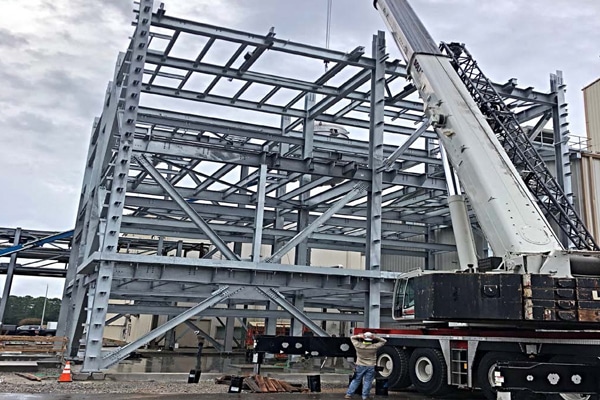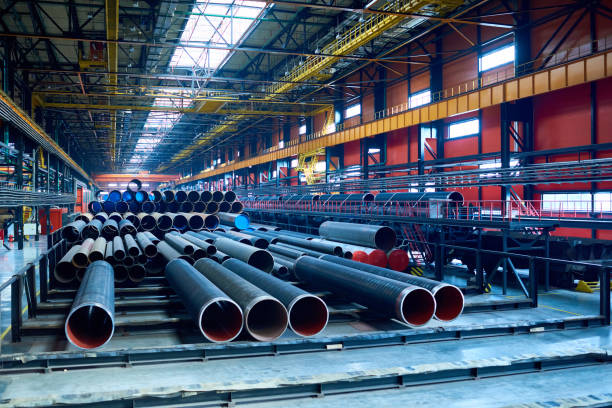Comprehensive Evaluation of Cutting-Edge Techniques in Steel Fabrication Sector
As the steel manufacture industry remains to develop, the assimilation of innovative techniques has actually ended up being important for remaining competitive and satisfying the demands of modern-day manufacturing standards. From laser reducing advancements to the application of robotics and 3D printing in steel manufacturing, the landscape of manufacture strategies is quickly changing. With each technology bringing its own collection of benefits and obstacles, a thorough evaluation of these strategies is paramount for business aiming to streamline their processes, boost precision, and inevitably, elevate the top quality of their steel fabrication outcome. In this vibrant industry where innovation plays a critical duty, understanding the nuances of these sophisticated techniques is not just an alternative but a requirement for those looking to create in advance in the ever-evolving globe of steel fabrication.
Laser Reducing Advancements
In the realm of steel construction, laser cutting developments have transformed the precision and efficiency of metal shaping processes. By utilizing the power of concentrated laser beams, manufacturers can now attain unparalleled levels of precision when puncturing various sorts of steels. This modern technology makes it possible for complex styles to be performed with minimal material wastage, making it an economical service for industries requiring high accuracy elements.
One of the key benefits of laser cutting is its capacity to take care of a large range of materials, consisting of stainless-steel, aluminum, and carbon steel, easily. The procedure generates tidy, burr-free edges, removing the requirement for additional ending up steps. The non-contact nature of laser cutting lowers the danger of product contamination, resulting in greater high quality end items.
Additionally, laser cutting makers can be programmed to make swift, specific cuts, considerably reducing manufacturing time contrasted to traditional cutting approaches. This rate and precision make laser cutting specifically ideal for mass production atmospheres where performance is paramount. As modern technology continues to breakthrough, laser cutting is positioned to play a progressively essential function in the steel manufacture industry.

CNC Machining Innovations
The evolution of CNC machining modern technologies has introduced a brand-new era of precision and effectiveness in the steel manufacture sector. Computer System Numerical Control (CNC) equipments have actually changed steel fabrication by providing unequaled precision and repeatability in the production procedure. Alpha reo. One of the crucial technologies in CNC machining is the assimilation of advanced software systems that enable real-time monitoring and adjustments, resulting in improved efficiency and quality assurance
In addition, the growth of multi-axis CNC equipments has actually permitted for the manufacture of intricate steel parts with complex layouts that were formerly testing to create. These devices can carry out a wide variety of machining operations, including milling, exploration, transforming, and grinding, all with high degrees of accuracy.
Additionally, the consolidation of automation and robotics in CNC machining has streamlined production procedures, lowered preparations, and decreased the margin of mistake. This combination of innovative innovations not only enhances effectiveness however also makes certain regular high quality across all made steel components. In final thought, CNC machining innovations proceed to drive improvements in the steel fabrication sector, setting brand-new requirements for precision and performance.
Automated Welding Technologies
Automated welding innovations have actually reinvented the steel fabrication sector, improving efficiency and accuracy in the welding process. These sophisticated innovations make use of computer-controlled systems to automate the welding process, leading to greater productivity degrees and improved weld high quality. Among the crucial advantages of automated welding is the capability to execute try this complicated welds with consistent accuracy, lowering the probability of mistakes and remodel.
Robot welding systems are at the leading edge of automated welding technologies, providing unparalleled rate and accuracy. These systems can deal with a variety of welding tasks, from straightforward to elaborate, with convenience (steel fabricators melbourne). By using innovative sensors and software application, robot welders can adjust to variations in product and joint geometry, making certain an uniform and trustworthy weld
Furthermore, automated welding innovations enhance office safety by reducing the direct exposure of human welders to hazardous fumes and intense warm. As the steel construction sector remains to evolve, incorporating automated welding innovations will be crucial for companies looking to stay competitive and satisfy the growing needs for high-grade bonded products.
Robotics Integration in Fabrication
Utilizing robotic systems in fabrication processes has become a pivotal strategy for enhancing efficiency and precision in modern manufacturing settings. Robotics assimilation in steel manufacture supplies a myriad of advantages, consisting of boosted performance, improved top quality control, and improved precaution. These sophisticated robotic systems are geared up with innovative sensing units and programs abilities, allowing them to perform detailed jobs with a high degree of accuracy and more tips here repeatability.
One of the key benefits of robotics assimilation in steel construction is the ability to automate recurring jobs, such as material handling, reducing, welding, and setting up processes. This not only speeds up manufacturing cycles however also lowers the danger of human error, bring about greater overall product quality. In addition, robots can run 24/7, dramatically improving production result and meeting limited project deadlines.

3D Printing in Steel Manufacturing
Having revolutionized the steel construction sector through robotics combination, the blossoming expedition of 3D printing in steel manufacturing is poised to additional development the world of contemporary production strategies. 3D printing, also called additive manufacturing, uses extraordinary layout freedom and complexity, allowing the creation of detailed steel structures that were previously unattainable through conventional manufacturing techniques. By utilizing computer-aided layout (CAD) software program, manufacturers can precisely manage the layer-by-layer deposition of steel product, leading to get rid of boosted capabilities and geometries.
Among the vital benefits of 3D printing in steel production is its capability to lower product waste dramatically. Unlike subtractive production procedures where excess product is trimmed away, 3D printing only uses the necessary amount of steel needed for the last component. This performance not just brings about cost financial savings however likewise lines up with lasting manufacturing techniques by lessening ecological effect.
Furthermore, 3D printing enables rapid prototyping and modification, permitting the production of small batches of intricate steel elements with short preparations. As the modern technology remains to mature and come to be extra easily accessible, its combination into mainstream steel manufacture procedures is expected to drive technology and effectiveness across the sector.
Verdict
Finally, the steel construction market has actually seen substantial advancements in techniques such as laser cutting, CNC machining, automated welding, robotics integration, and 3D printing. These advanced innovations have actually changed the means steel items are made, leading to increased cost-effectiveness, performance, and accuracy. Proceeded financial investment in these ingenious methods is important for the market to stay affordable and fulfill the needs of contemporary manufacturing processes.
As the steel fabrication industry proceeds to progress, the combination of advanced techniques has come to be necessary for remaining competitive and meeting the needs of modern-day have a peek at this site manufacturing standards.One of the key benefits of laser cutting is its capability to deal with a wide array of products, including stainless steel, aluminum, and carbon steel, with convenience.Automated welding innovations have changed the steel construction industry, boosting effectiveness and precision in the welding procedure.Having revolutionized the steel manufacture market through robotics combination, the growing expedition of 3D printing in steel manufacturing is positioned to additional advance the world of modern production techniques.In verdict, the steel construction sector has seen substantial developments in strategies such as laser cutting, CNC machining, automated welding, robotics combination, and 3D printing.